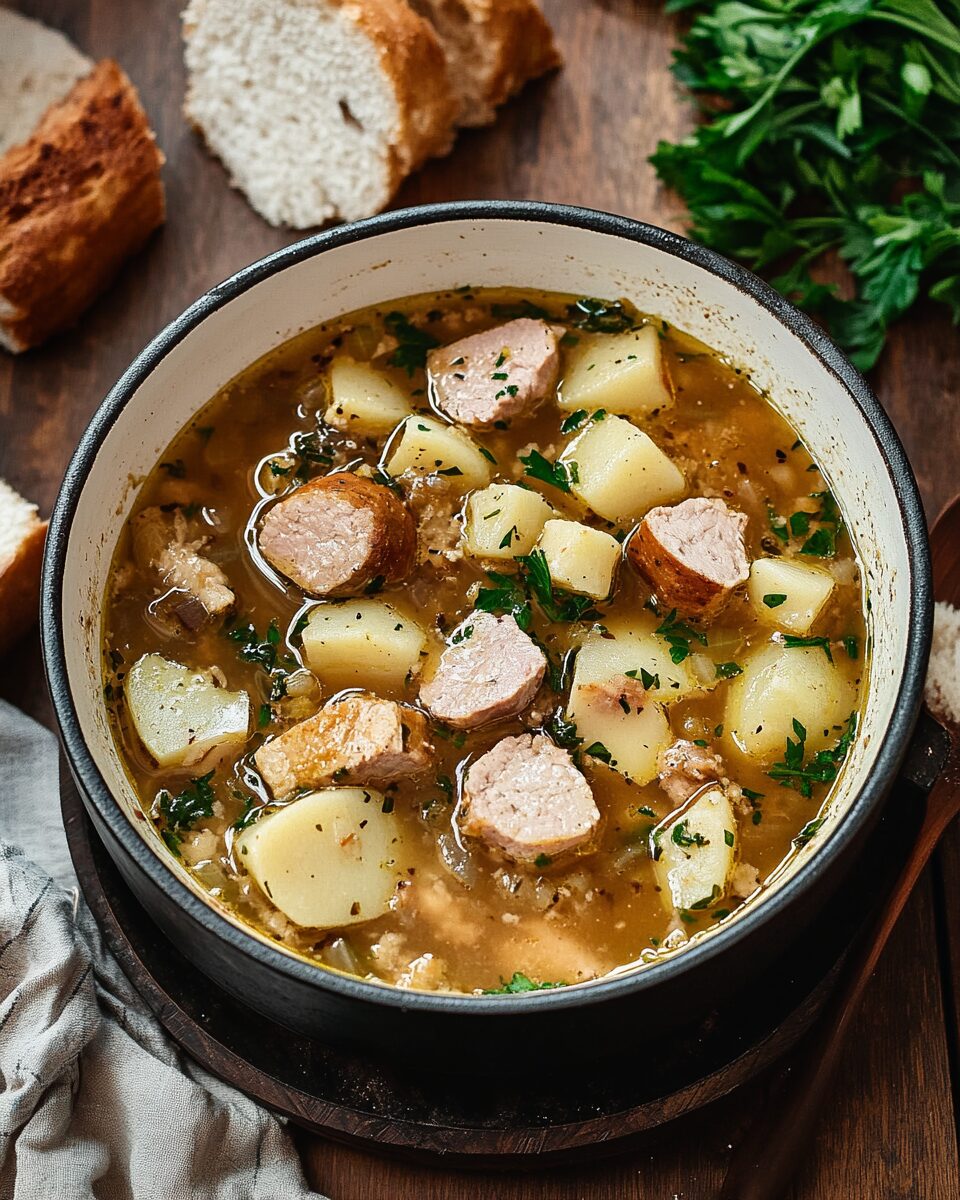Dublin Coddle is a beloved Irish comfort dish known for its layers of rich flavor and cozy, rustic character. Traditionally served in Dublin households, this humble stew brings together hearty ingredients like sausages, bacon, onions, and potatoes, all slowly braised in savory broth until melt-in-your-mouth tender. The aroma alone is enough to transport you to a kitchen in the heart of Ireland.
This dish is wonderfully forgiving and adaptable—ideal for weeknight meals, Sunday suppers, or festive St. Patrick’s Day gatherings. The layered cooking method infuses the broth with meaty goodness while the potatoes soak up every drop of flavor. It’s the kind of dish that welcomes you home with warmth and tradition, served best with a slice of crusty bread or a frothy pint.
Full Recipe
Ingredients:
-
1 tablespoon olive oil or butter
-
6 slices thick-cut bacon, chopped
-
1 pound Irish sausages (bangers)
-
2 large onions, sliced
-
2 cloves garlic, minced
-
4 large potatoes, peeled and sliced
-
2 cups chicken or beef broth
-
1 teaspoon dried thyme
-
Salt and freshly ground black pepper to taste
-
2 tablespoons chopped fresh parsley (for garnish)
Directions:
-
In a large skillet, heat olive oil over medium heat. Add the chopped bacon and cook until crisp. Remove with a slotted spoon and set aside.
-
In the same skillet, brown the sausages until golden on all sides. Remove and slice them into chunks if desired.
-
Layer half the sliced onions and garlic in the bottom of a large Dutch oven or oven-safe pot.
-
Add a layer of potatoes, followed by half the cooked bacon and sausage. Repeat the layers with the remaining onions, garlic, potatoes, bacon, and sausage.
-
Pour the broth over the layers and sprinkle with dried thyme, salt, and pepper.
-
Cover the pot with a lid and place it in a preheated oven at 350°F (175°C) for 1.5 to 2 hours, or until the potatoes are tender and the broth is mostly absorbed.
-
Garnish with fresh parsley before serving.
Prep Time: 15 minutes | Cooking Time: 1 hour 45 minutes | Total Time: 2 hours
Kcal: 480 kcal | Servings: 4 servings
The Rich History of Dublin Coddle
Dublin Coddle is one of Ireland’s most iconic and comforting traditional dishes, born out of necessity, resourcefulness, and the deep culinary culture of Irish home cooking. Known simply as “coddle” by locals, this hearty meal was originally a working-class staple in Dublin households. The term “coddle” comes from the method of gently simmering or “coddling” the ingredients—a technique that slowly coaxes flavor from humble pantry items like potatoes, onions, sausages, and bacon.
This dish dates back to the 18th century and is often associated with the Catholic tradition of not eating meat on Fridays. Coddle became a way to use up leftover sausages and rashers (Irish-style bacon) from the week. By combining them with pantry staples like potatoes and onions, families could avoid waste while still preparing a satisfying, filling meal. It’s said to be one of Jonathan Swift’s favorite meals—the famous author of Gulliver’s Travels—further adding to its literary and cultural significance.
A Dish Built on Simplicity and Flavor
What makes Dublin Coddle unique is its unpretentious and rustic nature. Unlike other stews that may be packed with a multitude of vegetables or spices, coddle sticks to the essentials: pork sausages, bacon, onions, and potatoes. The layering technique used in its preparation allows each ingredient to retain its integrity while contributing to the overall depth of flavor.
The dish is traditionally slow-cooked in the oven or stovetop, with each layer of potatoes and onions absorbing the savory juices from the bacon and sausage. A light broth, often made from stock or just water, keeps everything moist and melds the flavors into a unified whole. Some modern versions add herbs like thyme or parsley for extra aroma, but the heart of the dish remains deeply rooted in its original, minimalistic form.
Why Dublin Coddle Is So Loved
Dublin Coddle is more than just food—it’s nostalgia in a pot. It evokes memories of cozy kitchens, stormy Irish evenings, and family gathered around the table. It’s a comfort food classic that feels like a warm hug. This stew’s popularity has endured because it checks all the boxes: it’s budget-friendly, easy to prepare, deeply satisfying, and adaptable based on what’s available in your kitchen.
Coddle’s popularity peaks around Irish holidays, especially St. Patrick’s Day, but it’s enjoyed year-round in many households and Irish pubs alike. Its slow-cooked goodness makes it perfect for cold-weather meals, weekend dinners, or any time you’re craving a hearty, no-fuss dish that delivers maximum flavor with minimal ingredients.
A Perfect One-Pot Meal for Busy Lives
In today’s fast-paced world, the simplicity of Dublin Coddle is part of its charm. It’s the kind of one-pot meal that’s incredibly easy to assemble, requires very little attention once it’s simmering, and results in a dish that can feed a family with ease. It’s perfect for batch cooking or meal prepping, and the flavors deepen beautifully after a day in the fridge.
It also makes a fantastic dish to serve guests, especially when paired with a crusty loaf of Irish soda bread or a side of steamed green veggies. And because the flavors are mild but savory, it’s a dish that appeals to a wide range of palates—including picky eaters and children.
Versatility in Every Bite
One of the most appealing aspects of Dublin Coddle is its adaptability. While purists may insist on using Irish bangers and traditional rashers, there’s room for creativity depending on availability and dietary needs. You can substitute with any mild pork sausages, or even use turkey sausage or vegetarian alternatives to make a lighter version. Some cooks like to add carrots, leeks, or cabbage for added texture and nutrients.
The broth can also be tailored—use chicken broth, beef broth, or even add a splash of beer or apple cider for a unique twist. The seasoning can be adjusted with your choice of herbs, making it easy to infuse the dish with your personal preferences without straying too far from its roots.
Cultural Significance and Modern Appeal
Though it may have humble origins, Dublin Coddle has made its way into modern cuisine and culinary tourism. It’s featured in traditional Irish pubs around the world, highlighted in Irish food festivals, and even served in upscale restaurants that pay homage to classic Irish fare with elevated presentations.
Beyond Ireland, the dish has been embraced in places with strong Irish heritage like the United States, Canada, and Australia. Especially around Irish-themed celebrations or during the colder months, Dublin Coddle becomes a go-to for those craving something authentically Irish and soul-soothing.
Nutritional Benefits of Coddle
Dublin Coddle is surprisingly wholesome when made with fresh, high-quality ingredients. Potatoes provide a good source of complex carbohydrates, vitamin C, and potassium. Onions are rich in antioxidants, and lean pork sausages and bacon offer protein and essential B vitamins. By controlling the fat content through trimming or using leaner cuts, you can make a healthier version without sacrificing flavor.
If you opt to include additional vegetables like cabbage, carrots, or kale, you’ll boost the fiber and nutrient profile even more. And since it’s naturally gluten-free (depending on the sausage brand), it’s accessible to those with gluten sensitivities.
Serving Suggestions for the Perfect Coddle Meal
Dublin Coddle is a meal in itself, but you can enhance the experience with a few classic accompaniments. Serve it with a warm loaf of Irish soda bread or crusty baguette to soak up the savory broth. A side salad of bitter greens or a steamed vegetable medley can bring balance and freshness to the plate. For a truly Irish pairing, enjoy it with a pint of Guinness or a glass of dry cider.
It’s also a great recipe for sharing during family dinners, potlucks, or casual get-togethers. Serve it in the pot it was cooked in for a rustic presentation, or plate it up in deep bowls garnished with chopped fresh parsley.
Tips for Making the Best Dublin Coddle
-
Brown the meat first: This adds depth of flavor and texture. Don’t skip this step!
-
Layer wisely: Start with onions on the bottom—they help prevent sticking and flavor the broth.
-
Keep the broth light: You want a stew, not a soup. Add just enough liquid to cover the bottom layers.
-
Use waxy potatoes: They hold their shape better than starchy varieties during slow cooking.
-
Cover tightly: Whether baking or simmering, a snug-fitting lid traps the moisture and melds the flavors.
-
Let it rest: Like many stews, it’s even better the next day after the flavors have had time to mingle.
Variations to Try
-
Beer-Infused Coddle: Add a splash of stout or Irish lager to the broth for deeper richness.
-
Vegetable Boosted Coddle: Include sliced carrots, leeks, or kale for more nutrition.
-
Spicy Coddle: Add crushed red pepper or mustard seeds for a little heat.
-
Vegetarian Coddle: Use meat-free sausage and vegetable broth—still hearty and full of comfort.
Conclusion
Dublin Coddle is the epitome of Irish comfort food—simple, hearty, and packed with love. Its long-standing presence in Irish culinary tradition proves that the best meals don’t need to be fancy or complex; they need to be made with care, shared with good company, and savored slowly. Whether you’re honoring your Irish roots, looking for a cozy winter dish, or simply craving something deeply satisfying, Dublin Coddle is a timeless recipe that delivers every time. Add it to your rotation and experience the charm of Ireland, one spoonful at a time.






